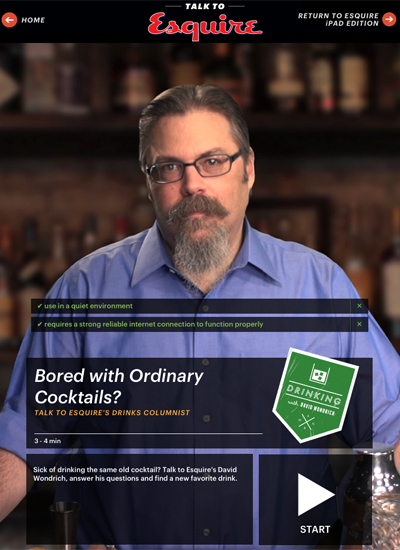April 1, 2013
Hearst Corp.’s Esquire magazine has rolled out a mobile application that uses a reader’s voice and an interactive question-and-answer session to serve up personalized content.
Esquire’s app uses the magazine’s fashion, grooming and drink personalities to assist readers find their perfect look or cocktail. The debate to Esq app works with iPad and iPhone devices, and is powered by Volio.
“Over the previous couple of years, since we did our e-ink moving cover in 2008 and our augmented reality issue in 2009, we’ve become a touch laboratory for cutting-edge media ideas,” said David Granger, editor in chief of Esquire, The big apple.

“In this example, Volio came to us and asked if we’d be game to let our readers experience something entirely new,” he said. “We thought it was cool, and that i hope we will both do more editorial iterations someday and get a number of Esquire’s advertisers to give thought utilizing it.”
Mobile match
The app’s homepage is sectioned off into three pieces of content where readers can get assistance on finding their perfect outfits and hair products or mixing up a brand new cocktail.
Esquire’s fashion director Nick Sullivan, drinks columnist David Wondrich and grooming expert Rodney Cutler dole out advice to users via pre-recorded messages.
Once readers click on a bit, they’re prompted to reply a couple of quick questions by speaking into their devices.
For example, Mr. Wondrich asks readers which sort of liquor they prefer, and Mr. Sullivan learns more concerning the form of event that they’re dressing up for.

Esquire’s Mr. Wondrich
The app also uses a handset’s built-in camera to drag the consumer’s face into the image next to the personality to construct at the idea of users having a one-on-one conversation.
Using sound recognition, the app serves up personalized drink and charm recommendations.
If readers don’t answer the question in a suite period of time, a button on the top of the page lights up to let readers select their answer from a listing of common answers.
Once the question-and-answer session is done, readers can share the content via Facebook and Twitter.
Additionally, there’s a link to Hearst’s Website where users can sign up for Esquire.
The app is being promoted in Esquire’s April print magazine and on Esquire.com
IPad subscribers can toggle from side to side between April’s digital edition and the debate to Esq app.

Readers can get style advice via the app
Interactive reading
Esquire has numerous mobile initiatives occurring.
Last year, Esquire worked with Netpage to mobilize each piece of content in its December issue through a mixture of image recognition, augmented reality and patented technology (see story).
Additionally, the magazine placed QR codes on its February issue to bring the quilt to life (see story).
There also are big differences in how Esquire readers consume content by devices.
“The consumption of any of our editorial on smartphones is a hasty information grab – of the entire ways that people experience Esquire, the telephone seems to me the least fulfilling,” Mr. Granger said.
“I still think print is where readers experience the foremost gratifying convergence of words, ideas, design and photography, and it’s where where individuals are most probably to provide themselves to a narrative,” he said.
“IPad is catching up though, and i’ve to assert that the magazine – while funny in print – is even funnier on iPad attributable to its versatility. And we’re considering they spend virtually as much time with the iPad version on average because the print, that’s fantastic as mobile and desktop consumption is frequently done with such haste.”
Final Take
Lauren Johnson is associate reporter on Mobile Marketer, New York
/>
